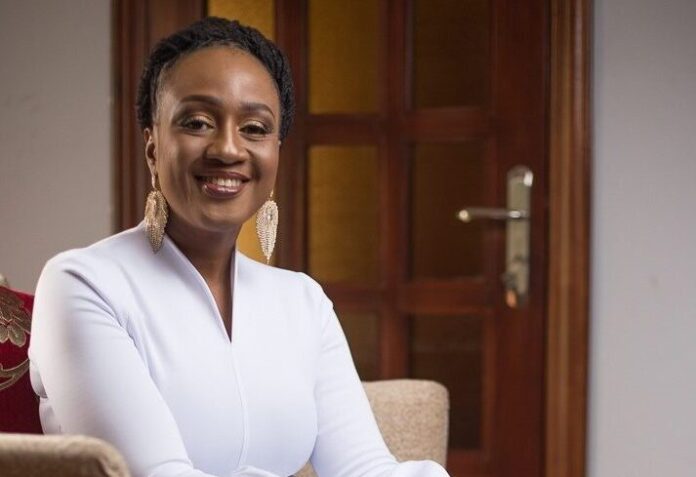I remember as a young lady growing up, I struggled to express myself. I was not very confident in the way I looked or thought and that always showed in the way I expressed myself. One morning I showed up to an interview: looking disgruntled and distressed. Immediately I walked into the room, the panel of interviewers could tell what kind of morning I was having and sadly, that set the tone for how the rest of my day went.
Communication is made up of so much more than words. Nonverbal cues such as tone of voice, gestures and posture all play their part. Body language is the unspoken part of communication that we use to reveal our true feelings and to give our message more impact.
You may have seen articles mention that 90% of our communication is non-verbal. It was Albert Mehrabian, a researcher of body language, who first broke down the components of a face-to-face conversation. He found that communication is 55% nonverbal, 38% vocal, and 7% words only. This is where the idea that most of the communication is nonverbal originated, but does this really mean that less than 10% of information is conveyed in spoken words?
An article by the University of Texas breaks down the thought behind the analogy – It turns out that the above formula was developed with a specific purpose in mind: comparing facial and vocal components to decipher a person’s attitude.
According to Mehrabian, “When there are inconsistencies between attitudes communicated verbally and postural, the postural component should dominate in determining the total attitude that is inferred.” Is 90% of communication nonverbal? No, information is conveyed verbally, but in a face-to-face conversation, body language and facial expressions can have an incredible impact on how information is interpreted.
In “The Definitive Book of Body Language,” Allan and Barbara Pease analyzed thousands of recorded sales negotiations from the 1970s and 1980s and found that body language accounted for most of the impact made negotiating. They also considered how the person with the strongest argument usually wins in negotiations over the phone but not always in face-to-face conversations. Although the idea that 90% of communication is nonverbal can be put to rest, a person’s body language and our first impression of them can heavily influence our decision-making.
As leaders, managers, and aspiring leaders, it is important that we communicate effectively, and this should be done through our verbal communication and non-verbal communication. Effective leadership depends on the ability to inspire and positively impact people.
But did you also know that the people you’re hoping to influence will be subliminally evaluating your credibility, confidence, empathy, and trustworthiness – and that their evaluation will be only partially determined by what you say? Did you know that your use of personal space, physical gestures, posture, facial expressions, and eye contact can enhance, support, weaken, or even sabotage your impact as a leader? So, it is important to know the impact of your body language and I discuss a few below.
First impressions are not final, but they are crucial. People make an impression of us in the first 7 seconds of interacting with us, and this is heavily dependent on our body language. In that short span of time, a person can decide whether we are trustworthy, collaborative, or whatever cues we may be communicating. We must be intentional about the aura and attitude we present when we meet people. It is possible to pick an attitude, and your brain will follow through. If you are having a bad day yet you decide that waling into your next meeting, you’ll want to be warm, you will break into a smile, keep an open body posture, make eye contact with anyone you meet and give hugs or handshakes on arrival.
Your hand gestures speak louder than words. Have you ever noticed that when people are passionate about what they’re saying, their gestures automatically become more animated? Their hands and arms move about, emphasizing points and conveying enthusiasm.
You may not have been aware of this connection before, but you instinctively felt it. Research shows that audiences tend to view people who use a greater variety of gestures in a more favorable light. Studies also find that people who communicate through active gesturing tend to be evaluated as warm, agreeable, and energetic, while those who remain still (or whose gestures seem mechanical or “wooden”) are seen as logical, cold, and analytic. That’s one reason why gestures are so critical to a leader’s effectiveness and why getting them right in a presentation connects so powerfully with an audience (Forbes, 2018).
Here are four common hand gestures and the messages behind them:
- Hidden hands make you look less trustworthy. This is one of the nonverbal signals that is deeply ingrained in our subconscious. In our prehistory, when someone approached with hands out of view, it was a signal of potential danger.
- Aggressive finger pointing can suggest that the leader is losing control of the situation – and the gesture smacks of parental scolding or playground bullying.
- If you want to project more enthusiasm and drive, you can do so by increased gesturing. On the other hand, over-gesturing (especially when hands are raised above the shoulders) can make you appear erratic, less believable, and less powerful.
- Grounded gestures. Arms held at waist height, and gestures within that horizontal plane, help you – and the audience – feel centered and composed. Arms at waist and bent to a 45-degree angle (accompanied by a stance about shoulder-width wide) will also help you keep grounded, energized, and focused.
Here are my 4 tips to develop better body language and non-verbal communication for deliberate engagement and influence.
- Mirroring is a technique you can develop to subtly mimic the positive body language of the person you are interacting with. It is one of the smartest ways to establish a connection with the person you are talking to and to essentially build rapport. To start, you want to give the other person your complete attention. Start by fronting the other person—that is, squaring your body so you are directly facing them. Establish eye contact; This not only demonstrates your interest level in the other person through your undivided attention, but, according to Dr. Kerstin Uväs-Moberg in her book The Oxytocin Factor, making eye contact releases oxytocin—this hormone is critical to create those warm feelings we feel when making a close connection. Lastly, triple nod to make the person you are speaking to know you are listening and that you understand what they are saying.
- Have a powerful posture. Sit or stand upright, with your shoulders back and your arms unfolded by your sides or in front of you. Don’t be tempted to put your hands in your pockets, or to slouch, as this will make you look disinterested. Stand in a relaxed manner, with your weight evenly distributed. Keep one foot slightly in front of the other to keep yourself steady. Avoid biting your nails, scratching your hair, touching your face, or looking away for long periods of time while you speak. This will make you look untrustworthy.
- Eye Contact: When a person makes eye contact with you, especially when you are talking, you feel important to that person, and your confidence in that person grows. According to Carol Kinsey Goman, Ph.d. and author of “The Silent Language of Leaders: How Body Language Can Help – or Hurt How You Lead.” “Just the right” amount of eye contact – the amount that produces a feeling of mutual likability and trustworthiness – will vary with situations, settings, personality types, gender, and cultural differences. As a rule, though, direct eye contact ranging from 40% to 60% of the time during a conversation – more when you are listening, less when you are speaking – should make for a comfortable productive atmosphere. Like our voice, our eyes convey everything. Eye contact connects us literally and figuratively with one another.
- Space – Leaders command the space around them visually and physically. They engage everyone in a room with their eyes and they physically interact, where possible, with all four corners of the room. In the second presidential debate of 2012, President Obama masterfully walked the stage from right to left, forward and back, commanding the theater of interaction. Influential leaders use their eyes and their physical presence to connect with the room. That means no hiding behind lecterns, using all the stage, confidently moving around and using their eyes to personally communicate with everyone present.
Successful leaders don’t just rely on instincts, instead they also strategically choose appropriate behaviors to achieve desired results. In order to be a successful leader at the highest levels, you need to not only understand exactly how your body language impacts perceptions, but you also need to be consciously aware of and choose behaviors that allow you to be the most influential. Anyone can understand, learn, and harness appropriate body language. A great way to start is by increasing your awareness through observation and practicing some of the above positive body language tips.
Are ready to stand out and lead your Image?
Read my book: “The Essentials of Image Leadership”.
Designed with practical exercises for home or office,
This book gives you all the essential tips and
Tools needed to sail with success in your image.
It also touches on dining etiquette,
Ensuring that in every space you find yourself,
You make a personal impact and achieve influence.











